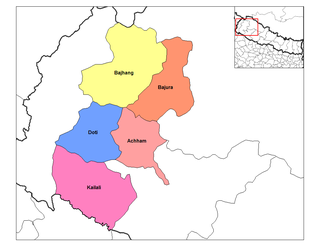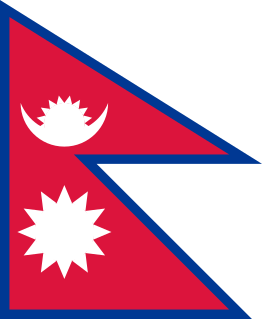The 1991 Nepal census was a widespread national census conducted by the Nepal Central Bureau of Statistics.

Amalachaur is a village development committee in Baglung District in the Dhaulagiri Zone of central Nepal. At the time of the 1991 Nepal census it had a population of 5,055 and had 943 houses.

Amarbhumi is a village development committee in Baglung District in the Dhaulagiri Zone of central Nepal. At the time of the 1991 Nepal census it had a population of 2,248 and had 409 houses in the village. It has been reported that the villagers of Amarbhumi VDC in Baglung district have changed their village's name to Mulabari.

Tauthali Hajipur is a village in Sindhupalchok District in the Bagmati Zone of central Nepal. Tauthali is 110 km to from Katmandu. In the 2013 Nepal census it had a population of 3,886 in 670 houses. After the devastating earthquake of 2072 almost every house was destroyed including religious sites such as Tripura Sundari Mai. The population grew to around 7000. The villagers started building concrete houses with the help of the government earthquake fund.
Naikap Purano Bhanjyang is a village and former Village Development Committee that is now part of Chandragiri Municipality in Kathmandu District in Province No. 3 of central Nepal. At the time of the 1991 Nepal census it had a population of 3456. The highest terrains in this village locate westernly, is ward No.5. A panoramic beautiful scene of whole Kathmandu Valley from Sanga to Nagarkot and Swayambhunath to Kirtipur Chobar can be viewed very clearly.The height of this hilly region lies in between 1600 m to 1800 m. The whole Himalayan range from Langtang to Mahalangur can also be viewed.

Ghairung is a village development committee in Gorkha District in the Gandaki Zone of northern-central Nepal. At the time of the 1991 Nepal census, it had a population of 4,348 and had 757 houses in the town. The village lies upon the crest of a mountaintop of which on the locals no the name, but which is certainly located at a very high altitude considering the village's location in the Himalayas. The exact altitude is also unknown, because even the most dedicated of land surveyors has the inclination to travel there and measure it.
Mukhiyapatti Musharniya is a village development committee in Dhanusa District in the Janakpur Zone of south-eastern Nepal. At the time of the 1991 Nepal census it had a population of 4,621 persons living in 436 individual households.

Chharka is a village development committee in Dolpa District in the Karnali Zone of north-western Nepal. At the time of the 1991 Nepal census it had a population of 552 persons living in 101 individual households. In the 2001 Nepal census it was found that 627 people identified as Buddhist and seven people identified as Hindu. It also stated that 544 people in 2001 were actually literate, 259 male and 285 female. there were also a total of 438 people who were non literate, 183 males and 255 females. Also according to the 2001 Nepal census there were a total of 634 people living in Chharka. Over one third of this population were in the age group of 4–19 years of age while only roughly about 9% of the population were the age of 50 or over.

Bhardeu is a village and former Village Development Committee that is now part of Konjyosom Rural Municipality in Province No. 3 of central Nepal. At the time of the 1991 Nepal census it had a population of 1746 in 310 individual households.

Lumle is a sub-urban and Village Development Committee in Kaski District in the Gandaki Zone of northern-central Nepal
- East side of this VDC is Paudhur Village,
- Sallyan village on south.

Ribhan is a village and Village Development Committee in Kaski District in the Gandaki Zone of northern-central Nepal. At the time of the 2001 Nepal census it had a population of 1,617 persons living in 372 individual households.Brahmin and Gurung are main ethnic groups in this village. Ribhan is mainly in the bank of Mardi river which is main source of irrigation for people of this agriculture-based village. The forest in this village has many endangered species such as Himali red panda and leopard. Much of its forest is still unexplored as it is very remote with high hills and sometimes snow. It is a part of Annapurna Conservation Area project.

Khiji Chandeshwari खिँजी/खिँचि,or खिजी चण्डेश्वरी is a village development committee in Okhaldhunga District in the Sagarmatha Zone of mid-eastern Nepal. At the time of the 1991 Nepal census it had a population of 3001 living in 590 individual households.

Marpha is a village development committee in Mustang District in the Dhawalagiri Zone of northern Nepal. At the time of the 1991 Nepal census it had a population of 1630 people living in 434 individual households.
Chhatiwan is a Village Development Committee in Doti District in the Seti Zone of western Nepal. At the time of the 1991 Nepal census it had a population of 3000 residing in 478 individual households. The name for this VDC comes from a lake that is situated in the village of Chhatiwan. This lake has fresh drinking water and teamed with various kind of fish. Lately due to the deforestation and soil erosion, this lake is being filled with all debris coming in due to the flash flood from its North side of the mountain. Budar is the major town of this VDC and at this town Dadeldhura and Jogbuda roads cross. Some of the major villages in this VDC are Budar, Ritha, Phaltude, Dharapani, Chhatiwan, Chhahara and many others. There are two small mountain streams that eventually meet up at Deujaal. A stream that comes from the Chhahara village has a wonderful water fall. The name of the water fall itself is Chhahara. In Nepali "Chhahara" means water fall. Once in a year there is a special festival at the foot of this water fall where people from many surrounding villages come and celebrate throughout the night. The festival begins in the evening and people sing, dance and merry all through the night. This is also the night when lovers elope if the family does not agree for their marriage. Along the stream grows a plant called "sisnu". This plant has mild poisonous element and once the Caterpillar type of hairy things get stuck in the skin, the skin will be burning for a long time. But the belief is that once in a year after the festival you have to be stung by that plant so that you will remain healthy throughout that year. So, people will be chasing each other in the morning to torture each other with that plant. Some times drinking creates big fights among the villager.
Chhatiwan VDC is also popular for a model school in far west Nepal. Rampur School is the oldest school and now it has school for the disabled children for the whole of Far west. There is also an Army School in Budar. During the construction of Dadeldhura Highway, Budar was very important place as it was the headquarters for the road construction department.

Bagarchhap is a village development committee in Manang District in the Gandaki Zone of northern Nepal. At the time of the 1991 Nepal census it had a population of 534 people living in 116 individual households.

Halkhori is a village development committee in Mahottari District in the Janakpur Zone of south-eastern Nepal. At the time of the 1991 Nepal census it had a population of 4471 people living in 720 individual households.Halkhori has three villages named Halkhori, Bhangahiya and Chakwa
{{Infobox settlement |name = Itari Parsahi |other_name =Itari prasahi |native_name = इटरी पर्साही |nickname = |settlement_type = [[Riverdale development peoplesssss (Nepal)] |motto = |image_skyline = |image_caption = |image_flag = |image_seal = |image_map = |mapsize = |map_caption = |pushpin_map = Nepal |pushpin_label_position = bottom |pushpin_mapsize = 300 |pushpin_map_caption = Location in Nepal |subdivision_type = Country |subdivision_name = Nepal |subdivision_type1 = Zone |subdivision_name1 = Sagarmatha Zone |subdivision_type2 = District |subdivision_name2 = Siraha District | |government_footnotes = |government_type = |leader_title = |leader_name = |leader_title1 = |leader_name1 = |established_title = |established_date = |unit_pref = |area_footnotes = |area_total_km2 = |population_as_of = 1991 |population_footnotes = |population_note = |population_total = 3302 |population_density_km2 = auto |population_blank1_title = Ethnicities |timezone = Nepal Time |utc_offset = +5:45 |timezone_DST = |utc_offset_DST = |coordinates = 26.74°N 86.19°E |elevation_footnotes = |elevation_m = |postal_code_type = |postal_code = |area_code = |blank_name = |blank_info = |website = |footnotes = }}

Raksirang is a very small village development committee in Makwanpur District in the Narayani Zone of southern Nepal. At the time of the 1991 Nepal census it had a population of 6343.

Biranchi Barwa is a village development committee (VDC) in Parsa District in the Narayani Zone of southern Nepal. At the time of the 2011 Nepal census it had a population of 3,625 people living in 558 individual households. There were 1,846 males and 1,779 females at the time of census.

Palhi is a village development committee in Nawalparasi District in the Lumbini Zone of southern Nepal. At the time of the 1991 Nepal census it had a population of 4133 people living in 625 individual households. The only spoken language here in Bhojpuri(Awadhi); about 99% of the population speak bhojpuri and the remaining speak tharu, nepali and Urdu(<1%). The Palhi Bhagawati Mandir is a holy temple of goddess durga. Thousands of people worship in this temple during the festive season of nawami(dureshara). It is believed that what you wish for will be fulfilled if you visit the temple. The temple is very much popular in the district. Most of the people are under poverty line. Even in this century, the villages don't have access to roads and education. There is only one higher secondary school in the VDC.But, most of the youngsters travel to foreign for money. Very less students migrate to the Capital for higher studies.









